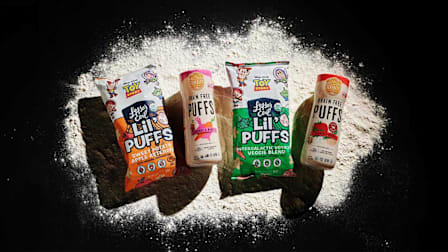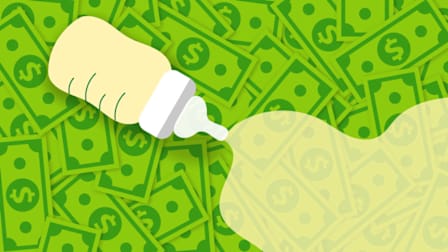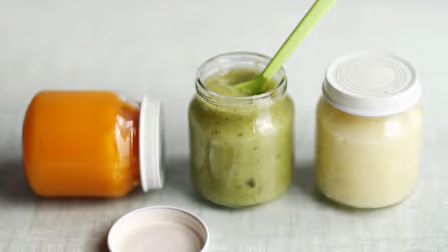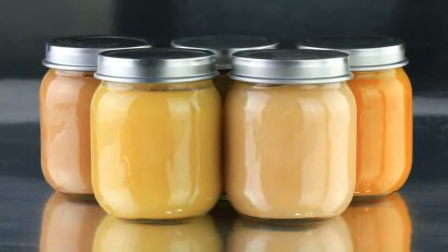Best Baby Food Companies for Reporting Lead, Arsenic, and Other Toxic Elements
Earth's Best, Once Upon a Farm, and Plum Organics earned top scores
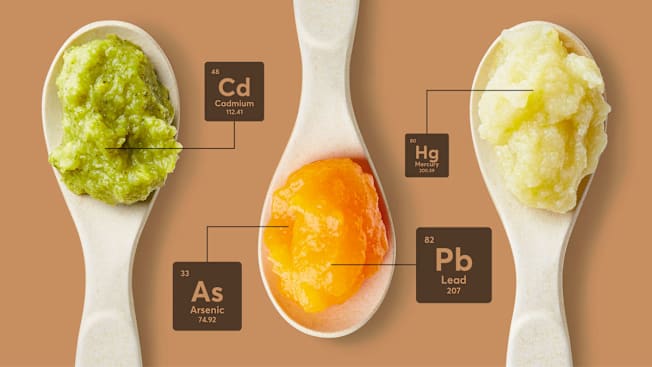
Consumer Reports and Unleaded Kids, a nonprofit focused on protecting kids from lead exposure, recently evaluated 39 baby food brands to see how easy they make it for parents to check their baby’s food for contaminants. A new California state law requires testing for toxic elements in most baby food, including lead and arsenic—and the public disclosure of those results. We looked at established brands like Gerber and Happy Family Organics’ Happy Baby Organics, as well as newer companies like Cerebelly and Little Spoon. What we found was mixed.
While 17 baby food companies—including Earth’s Best, Plum Organics, and Once Upon a Farm—have tested their products for arsenic, lead, cadmium, and mercury and are providing straightforward access to their test results, 20 companies—including Little Spoon, Sprout Organics, and Beech-Nut—require consumers to track down additional information, including best-by dates, lot numbers, or UPCs (unique serial numbers), making the process of accessing test results more difficult for busy parents. Two smaller companies don’t have any test results publicly accessible on their sites yet.
Underlying these transparency efforts is California Assembly Bill No. 899 (AB 899 for short), which passed in 2023 and requires all baby food manufacturers selling in the state to test their products at least once a month for lead, arsenic, cadmium, and mercury; it took effect Jan. 1, 2024. At the start of 2025, baby food manufacturers selling their products in California had to make those test results publicly available to consumers on their websites and via QR codes on the product labels. The law covers baby food, snacks, and supplements for children under 2 (we didn’t include those for this report) but does not include infant formula. (CR conducts its evaluations for the purpose of providing comparative information and not for compliance.)
Why Reducing Heavy Metal Exposure in Early Childhood Matters
Exposure to heavy metals is harmful to all humans, but it can be especially detrimental in infancy and early childhood—a period of rapid growth and development. “Children are estimated to take in about three times as much food as adults when compared to their body mass,” says Emily Bair, MPH, RDN, a dietitian, researcher, and site engagement coordinator at the Michigan Value Collaborative. “Therefore, their accumulation of toxic element exposure is potentially much greater during a relatively short period of very important development.”
Because even low levels can accumulate in the body over time, heavy metal exposure can lead to potentially harmful conditions, including anemia, kidney damage, developmental and neurological delays, nervous system damage, and reproductive toxicity, as well as cancer, according to a 2022 “Frontiers in Nutrition” review Bair authored.
Unfortunately, toxic elements are everywhere in our environment and our food supply, arising from both natural and artificial sources. Lead, arsenic, and cadmium are regularly found in fruits, vegetables, and grains—primary ingredients used in both store-bought and homemade baby food. (Mercury is less commonly found in baby foods but is often detected in seafood and sea vegetables.)
The Food and Drug Administration’s Closer to Zero plan aims to reduce children’s exposure to lead, cadmium, arsenic, and mercury while maintaining access to nutrient-rich foods. The plan was announced in 2021, though progress has been slow: The action levels for lead in baby food were published in January 2025, but the final action levels for cadmium, arsenic, and mercury are still in development.
“FDA’s action levels for baby food are set to keep only foods with the highest levels off store shelves. We believe the agency could take much stronger action and better balance the known health risks by driving contamination closer to zero,” says Tom Neltner, national director of Unleaded Kids. “That is why groups like Unleaded Kids and Consumer Reports urged the new FDA leadership to reconsider their lead action levels and have championed laws like California’s AB 899 that push companies to reduce exposure to dangerous toxics.”
What AB 899 Means for Baby Food Companies
AB 899 has strict requirements for all baby food companies selling products in California, regardless of their size or sales volume.
Mandatory testing of final products for four toxic elements (arsenic, cadmium, lead, and mercury): Testing is required at least once a month.
Sharing testing results online: Test results must be available on the company website, with the name and level of each toxic element present. Test results must be available for one month past the product’s shelf life.
Labeling tested products with QR codes: The product must have a QR code that links to the online test results.
Testing must be done by an accredited laboratory: According to the law, the laboratory used must be able to test toxic elements to a concentration of at least 6 parts per billion (ppb).
The California Department of Public Health (CDPH), which enforces the law, defines “baby food” as food “packaged in jars, pouches, tubs, and boxes represented or purported to be specifically for babies and young children less than two years of age.”
“Compliance is ensured through reporting by consumers and labeling reviews conducted during inspectional work. If someone is aware of a person or entity who is not compliant with AB 899, they can report the matter using the complaint form on the CDPH website,” a representative from the California Department of Public Health says. If a baby food manufacturer or retailer doesn’t comply with AB 899, it is prohibited from selling or offering for sale their products in California. They may also be subject to penalties or risk having their company registrations and licenses revoked.
When CR asked whether the agency has sent out any enforcement notices to companies that might not be in compliance with the law, the representative said that “CDPH does not share consumer complaints and investigative reports as these are exempt from public records.”
AB 899 has some limitations in its scope, however. “The law does not establish guidelines for the allowable levels of heavy metals in baby food,” Ronholm says. “It also only requires testing of finished products and disclosure of results.”
And while the statute specifies that “information must be made publicly available on the manufacturer’s internet website,” CR and Unleaded Kids found various interpretations of this language, with some companies requiring sell-by dates, UPCs, or captcha verification to access the test results.
How Did the Companies Do?
Consumer Reports and Unleaded Kids set out to answer one question: How easy is it for consumers to find heavy metal testing results for baby food? We looked at 39 baby food brands, both those that offer a wide range of products and those that only offer one specific product, like yogurt or cereal.
We then rated the brands on transparency from better to worse using the following criteria.
A consumer can easily find all test results for products on the brand's website.
A consumer must locate and enter a 12-digit UPC number to access a product's test results.
A consumer must click on best-by dates to find products and only then access test results.
A consumer must locate and enter a lot code, best-by date, or batch number to access test results. Consumers only see the result for that lot code.
No public webpage found to access test results.

Loco Bebé
Piko Provisions
*These companies send consumers to a third-party site for test results.
Keep in mind that for this review, CR and Unleaded Kids looked only at how transparent baby food companies are in sharing their testing results, and did not rank products based on the results themselves, given that some companies didn’t report results. Results are current as of August 2025.
About These Results
In our transparency ratings, we looked at how easily consumers can find and review levels of arsenic, cadmium, lead, and mercury in baby foods and compare results across brands, products, and lots.
We gave the highest ratings to brands that made test results for all their products easily accessible on their websites. The examples below represent the range of what we saw in our ratings criteria.

Graphic: Consumer Reports Graphic: Consumer Reports
We gave a lower rating to brands that required consumers to enter a lot code or UPC, which would require having a product in hand.
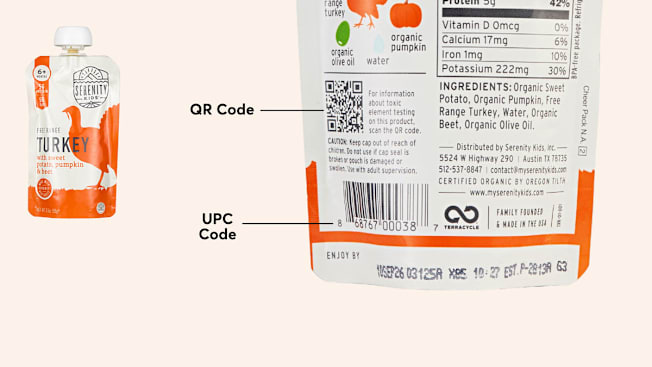
Graphic: Consumer Reports Graphic: Consumer Reports
Typing in a lot of digits to access results not only is tedious but also introduces a higher potential for mistakes. Similarly, selecting a best-by date from a calendar makes it difficult to compare results across lots. Consumers may also have difficulty finding the best-by date or lot number on their product, which is not always in a standard location, like the UPC.
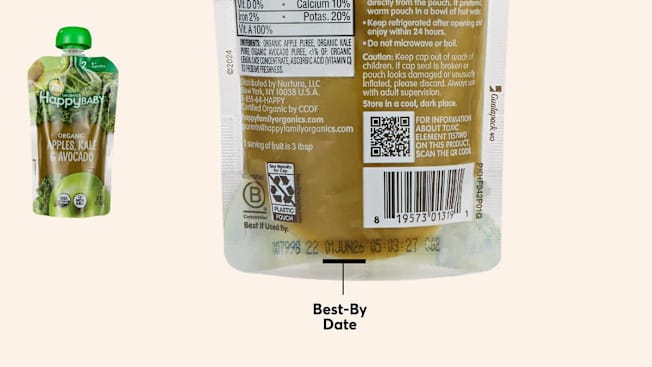
Graphic: Consumer Reports Graphic: Consumer Reports
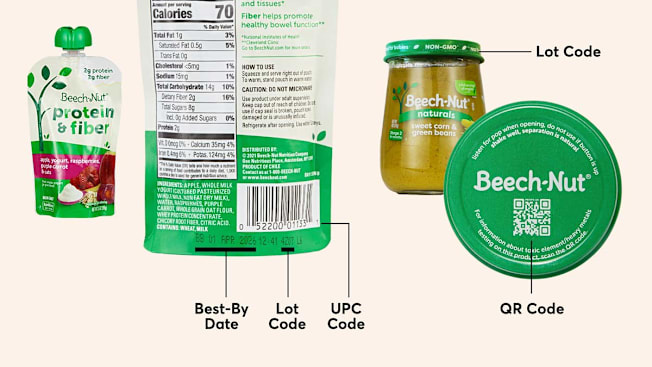
Graphic: Consumer Reports Graphic: Consumer Reports
Some brands may include a QR code on the product packaging but have no centralized listing of test results available on their site, which makes it difficult for parents and caregivers to gather information about a product before they shop.
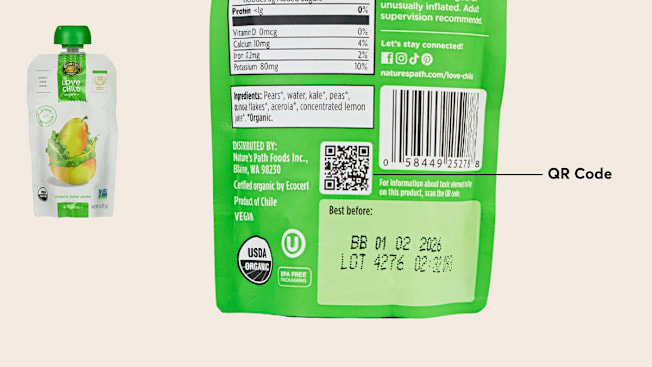
Graphic: Consumer Reports Graphic: Consumer Reports
Overall, we found that there’s a wide interpretation of compliance when it comes to following AB 899’s disclosure guidelines. Whereas some brands have publicly shared hundreds of test results across their full range of products, even for those designed for older kids, other brands still have missing test results for some products—or have yet to publicly share test results as of August 2025.
Baby Food Companies Respond
CR contacted all 39 of the baby food companies in our ratings. We asked whether they test both raw ingredients and finished products for toxic elements, what steps they’re taking to mitigate toxic elements in their products, and whether they’re planning to expand their testing to all products, not just those for children under 2. We received responses from most of the companies.
Brainiac Foods, Cerebelly, Earth’s Best, Gerber, Kendamil, Lil’ Gourmets, Mission MightyMe, Nestum/Cerelac, Once Upon a Farm, Plum Organics, Pumpkin Tree, Square Baby, and Stonyfield Organic all scored at the top of our ratings for transparency, and each sent detailed responses about their testing process and transparency goals.
Pumpkin Tree, which includes a range of purée pouches, said that in addition to testing finished products, it requires suppliers to provide test results for every batch of ingredients and performs additional random tests to check that the supplier’s test results are valid.
The manufacturer takes formulation into consideration, too, because some research shows that combining foods rich in certain nutrients, like iron, can help protect against heavy metal absorption. “We use data/trends as they become available to craft recipes around particularly sensitive ingredients [such as spinach and root vegetables] to lower the overall levels in products, [and we] have in place a predictive ‘desktop’ model to help guide the use of specific batches of ingredients to ensure that the overall levels of heavy metals in products are kept as low as practicable,” a Pumpkin Tree rep said.
Square Baby, a baby-focused meal delivery company, said it vets farms and suppliers and selects those that have implemented systems to reduce heavy metals in their soil. It also said it works with a lab that tests finished products for contaminants down to 3 ppb—which is more stringent than the 6 ppb required by AB 899. The company also advises parents to offer babies a variety of foods as part of a strategy to lower heavy metal exposure. “Offering a variety of foods will not only reduce heavy metal exposure, but it will also ensure your baby is getting a variety of nutrient-dense foods, antioxidants, as well as important, naturally occurring vitamins and minerals like calcium, iron, zinc, selenium, magnesium, and vitamins C and D to help block metal absorption and increase elimination from the body,” said co-founders Katie Thomson, RD, and certified genetic counselor Kendall Glynn.
Cerebelly, which offers a line that includes purées, bars, and smoothie-style purées, said it also monitors its supply chain. “By closely managing and monitoring our supply chain and our production results, we’re able to maximize the brain-supporting nutrition benefits while minimizing the exposure to heavy metal risks,” a rep for Cerebelly said.
In addition to partnering with growers who regularly test their soil, water, and products for heavy metals, companies can manage exposure by improving their processing techniques, says Emily Bair at the Michigan Value Collaborative. That might include peeling, polishing, and cleaning produce thoroughly to remove surface residues and contaminants, which tend to accumulate in the outer skins of root vegetables and the bran layer of grains.
Reformulating products is another option. By incorporating higher ratios of ingredients that are lower in toxic elements, companies can reduce their overall levels of contaminants, Bair says. Continuing to test and monitor supplies along with production and being transparent with consumers and regulatory agencies also remains important.
A company representative for Cerelac, Nestum, and Gerber, all brands owned by Nestlé, wrote: “We test crops, water, ingredients, and final products to ensure we deliver on our promise to make high-quality, safe baby food. We regularly test for hundreds of toxins and contaminants, and our products must pass more than 100 individual quality checks before they can be sold. Any product that doesn’t meet our strict safety and quality standards is simply not released for sale.”
Once Upon a Farm, Plum Organics, and Square Baby voluntarily made their 2024 testing results publicly available, which the companies say goes beyond what’s required by AB 899. “Our approach to testing has always been rigorous and thorough,” said Jane Ablaza, director of marketing communications and brand partnerships at Once Upon a Farm. “Using accredited labs, each lot of our products undergo multiple types of testing, including microbiological testing and heavy metal testing to verify that they meet our high standards for quality.” Both Once Upon a Farm and Plum Organics also provide test results across their entire product lines, including snacks for kids older than 2.
In our analysis, we noticed that Kekoa Foods, a line of purée pouches, had test results publicly accessible on its website but was not using a laboratory with the ability to detect toxic elements down to 6 ppb. CR reached out to ask about its choice to report a non-detect level of lead only down to 10 ppb, and the company told us it was moving to a new lab that quantified down to 6 ppb. As of October 2025, the company’s website reflects test results using this more sensitive level.
CR also heard from several companies that scored in the middle of our ratings because they required an extra step from the consumer, such as completing a captcha or needing to purchase the product before checking test results in order to enter a best-by date, lot number, or UPC.
Little Spoon, a line of purées, premade meals, and snacks, said that because it is a direct-to-consumer brand, it doesn’t use UPCs or display products on physical store shelves, so requiring a lot code to access test results “provides a traceable and accurate mechanism to link a consumer to the specific testing results for the product they received,” according to Kerri Jimenez, vice president of quality and food safety. “We have consulted with multiple legal experts familiar with California AB899 and continue to believe, in good faith, that our approach is fully compliant with the law as written. To date, we have not received any consumer complaints or confusion regarding the accessibility or clarity of this information.”
We heard a similar response from Babylife Organics, which sells a line of purées in pouches and jars. The company requires consumers to enter a lot number to view test results. “Heavy metal levels can vary between ingredient lots and production runs, and we believe it’s more responsible to share precise data for the exact package of baby food, rather than averages or representative samples,” said founders Doug Brent and Richard Harford. They also share that they’re open to updating their site “to add an additional section where consumers can see the complete list of finished goods’ third-party test results for all product lot codes we have ever produced.”
Beech-Nut, which sells purées, cereals, and snacks, said that customer feedback informed the design of its testing results platform. “We have learned they want context, and also specific information about products they are actually buying,” a company spokesperson said. “Requiring a lot number allows us to provide specific information on the products of interest.” It remains committed to continually refining its approach in response to consumer feedback, the company rep said.
Sprout Organics also requires a lot number to check test results. “At this time, we have chosen to use a system that uses a UPC/Lot # to pull results. We are more than happy to provide results when they are requested. We will readdress how we share results in 2026,” a company rep said. It’s also planning to expand its testing to products for children over age 2 in the future, the rep said.
Little Bellies, a line of baby food purées and snacks based in Australia, said that all of its ingredients, recipes, and suppliers “are specially screened and selected to ensure they are appropriate and safe,” noting that it tests and reports on all of its products in the market, including its line of toddler snacks. However, it requires a lot code to access product testing results. “All our products meet best-in-class international standards, with the use of lot codes enabling search for batch-specific results,” a company representative said. “We are continuously improving and adapting the ways in which these results are best displayed for a smooth user experience.”
Happy Family Organics, which makes Happy Baby Organics, requires entering a best-by date and product name before viewing results, and the company pushed back against CR’s midlevel rating. “Based on our own review of other sites and comparing them to the simplicity of ours, we are very surprised to hear that Consumer Reports intends to identify Happy Family as falling in the middle of the list with respect to this particular measure of ‘transparency,’” a company spokesperson said. “We believe the simplistic nature of inputting product category and date allows for an easy and transparent search experience, and is the best approach for getting parents and caregivers the information they need. That said, we are open to feedback from our consumers for future iterations.”
While there is no centralized listing of test results on Kroger’s site for its private label Simple Truth, which makes purées in pouches and jars, test results are accessible by QR code and lot code on products sold in California. “Customers can access heavy metal testing results through QR codes featured on the product packaging,” a company representative said. “In accordance with the California legislation, any impacted product produced after January 1 has the required QR code available on the packaging.”
For Parent’s Choice, which is Walmart’s private label, test results for baby foods are accessed through a QR code and lot code on product packaging. “Walmart complies with all applicable regulations and requires our suppliers to comply with all applicable regulations and company requirements, including those for Walmart baby food products subject to California AB 899,” a company spokesperson said. To find test results for Parent’s Choice products, parents need to scan the QR code to open the web page, scroll to find their product on the list, locate the lot number on the product package, and fill out a captcha form.
Love Child Organics, which makes purées and snacks, uses a similar system, with test results accessible by lot code via a QR code on the package. “Each of our purees features a scannable QR code that links to a webpage where you can view the results of our heavy metal testing,” said Angie Sell, communications manager at Nature’s Path Organic, which operates Love Child Organics. Sell also said that in November 2025, consumers will be able to scan the QR code and be taken to a page on the company’s own website that will allow them to check for the same results.
We also heard from both of the companies that landed at the bottom of our ratings for labeling transparency.
When we notified Piko Provisions, which makes a line of purée pouches focused on foods and flavors from Hawaii, that we couldn’t find test results on its site, Ethan West, founder, responded that the manufacturer is currently working with a third-party testing company to test products for contaminants, including heavy metals, and is working on making those results accessible to customers, in compliance with AB 899. “However, these updates require both time and funding—both of which are incredibly limited for us as a tiny company, especially in contrast to the large multinational corporations in our space,” West said. “We believe deeply in the importance of transparency, and while we’re not yet where we want to be, we are taking concrete steps toward full compliance and providing clear, accessible information for our community.”
Loco Bebé also let us know that the company is working to publish its test results on its site, but no results appear yet. At the time of publishing, the Heavy Metal Reports page on its site turned up a 404 error. “As a small family-owned company, it takes a little more time to get new processes in place. The test results for our lots will be live on our website shortly so parents can access our test results for our finished products,” a company representative said. “All these test[s] are very expensive and the financial burden can be difficult for small companies like ours who are trying to make a difference . . . but we know it is important for parents’ peace of mind and ours.”
We didn’t receive responses from Amara, Baby Mum-Mum, Else Nutrition, Fresh Bellies, Good & Gather Baby (Target’s private label), Holle, Little Journey (Aldi’s private label), Nurture Life, O Organics (Albertsons’ private label), Puffworks, Ready Set Food, White Leaf Provisions, or Yumi.
What Our Ratings Mean for Parents and Families
It’s unsettling to have to grapple with the fact that heavy metals might be included in your baby’s spoonfuls of puréed sweet potatoes and peas. Understanding what’s in your little one’s meals can help you make an informed choice.
“AB 899 addresses a significant lapse in current federal oversight to mandate final-product testing and public disclosure related to heavy metals in baby foods,” Bair says. But that’s only if brands uphold their end of the bargain and regularly share their monthly test results—while making them easy to find and simple to understand.
Here’s how to use this information to make the healthiest possible choices for your family.
Seek Out Companies That Prioritize Transparency
Before you shop, look for brands that clearly list all test results for products on their website. Some have “AB 899” in their site footers; others may have a page dedicated to safety or transparency. Many of the baby food companies we rated highly for labeling transparency say they are taking an active role in sourcing ingredients with lower levels of potential heavy metal contamination to help mitigate risk, and testing through all stages of their production process to pinpoint supply chain issues.
When you’re shopping in a store, you should be able to easily find a scannable QR code on the back of the product packaging, whether it’s an individual pouch, a jar, or a boxed set.
Look for the Lowest Possible Levels of Toxic Elements
Lead, arsenic, cadmium, and mercury are found in many foods, making them hard to avoid altogether. “The goal is to drive how much your baby is consuming closer to zero,” Neltner says. According to the American Academy of Pediatrics (AAP), multi-ingredient baby food blends may be a good option over single-ingredient purées because they increase dietary variety, which can help lower the risk of exposure to toxic elements. “Be aware that many have the same first or second ingredient, though. Different flavor blends, like kale/pear and spinach/pumpkin, for example, may actually both have sweet potatoes as their first ingredient,” the organization says on its site. That’s why a quick scan of the ingredients label is helpful.
Keep in Mind That ‘Not Detected’ Doesn’t Mean Zero
Some brands may list their test results as “too low” to be detected, using the term “non-detect” or ND. But an ND result doesn’t necessarily mean the absence of heavy metals.
AB 899 requires a threshold of 6 ppb for each toxic element, though more sensitive assessments exist: Happy Family Organics tells CR that it uses a lab with a level of detection for these toxic elements down to 2 ppb, and Earth’s Best test results show levels down to below 1 ppb. But not all brands offer that level of transparency. Because the law requires testing only down to 6 ppb, a company could list a result as “ND” for anything under that threshold, without being more specific. “That puts even more burden on the consumer to look up what the ND means,” Neltner says.
Ultimately, if there’s no explanation about how the testing was performed or how serving sizes relate to the level of exposure, then disclosure alone doesn’t do much. A lack of context around results can be misleading, erode trust, or cause further worry for parents already dealing with information overload and decision fatigue.
Take Serving Size Into Consideration
When looking at testing results, you’ll see brands report results in parts per billion (ppb), which is a ratio, not an amount. While being able to view ppb levels can make it easier for parents to make comparisons, note that ppb doesn’t take serving size into account. If you’re looking to estimate the amount of toxic elements in the pouch or jar you’re planning to feed your baby, you can use this calculation: Parts per billion is equivalent to micrograms per kilogram, so 1 ppb = 1 mcg/kg. As an example, if one sample has 5 ppb of lead, you can multiply 5 by the weight of a single serving size for that baby food (in kg) to get the total weight of lead in a single serving.
Example: 5 mcg/kg lead x 0.099 kg (serving size of 1 pouch) = 0.495 mcg of lead in the serving size (1 pouch)
Is Homemade Baby Food Safer Than Store-Bought?
It’s difficult to avoid heavy metals in baby food that you make at home because both homemade and store-bought baby foods carry the risk of containing heavy metals, says Natalie D. Muth, MD, MPH, a pediatrician, dietitian, and AAP spokesperson. “And it really doesn’t matter if it’s organic or not—the potential exposure is about the same,” Muth says.
As to whether making baby food at home is the safest option: Not necessarily, Muth says. “Store-bought infant foods could in fact be a little safer when it comes to heavy metal exposure because they are routinely tested,” she says. “Homemade food, on the other hand, is not subject to testing, so parents and caregivers need to be mindful about the types of foods that tend to have higher levels of metals like mercury, lead, cadmium, or arsenic.” Muth says that rice, root vegetables, and certain fish, like swordfish and some types of tuna, are the worst offenders.
How to Reduce Heavy Metal Exposure in Baby Food
Whether you’re feeding your baby homemade or store-bought food, here’s what experts recommend.
Increase variety. Rotate foods regularly and aim for a wide variety of fruits, veggies, leafy greens, and grains in your child’s diet, both to maximize nutrition and to lower the overall risk of exposure.
Steer clear of rice. Try to avoid rice (especially infant rice cereal and products made with brown rice syrup), which can be high in arsenic. “While we used to recommend rice cereal as a good first food, pediatricians now advise against rice cereal and recommend using alternative grains instead, such as infant oatmeal fortified with iron,” Muth says.
Aim to include iron, calcium, and vitamin C in your baby’s diet. Making sure your baby gets good sources of these essential minerals can reduce their absorption of heavy metals from food and the environment, Bair says. Vitamin C helps the body absorb iron more efficiently, and, combined with adequate iron intake, may help reduce the absorption and retention of toxic heavy metals.
Consider peeling produce. Peeling any root vegetables before cooking potentially reduces your child’s exposure to toxic elements. One 2023 study found cadmium and lead in unpeeled sweet potatoes and white potatoes, but those toxic elements were not present when the potatoes were peeled. However, as peels and skins of veggies are host to fiber and other vitamins and minerals, removing the peels can mean some nutrient loss. Zucchini and lentils are good alternatives, too, Muth says.
Limit juice. Offer fruit juice only sparingly (no more than 4 to 6 ounces) for children over 1 year old, and give none at all to children under 12 months of age, according to the AAP. Fruit juice can contain elevated levels of heavy metals, and the AAP says it offers no nutritional value over fresh whole fruits, which provide fiber and other important nutrients.
Editors’ Note: This article, originally published Aug. 7, 2025, was updated Oct. 15, 2025, to reflect updated testing standards for Kekoa Foods. The brand had originally been classified as an Orange on CR’s Transparency Rating chart. It is now in our Dark Green category.

















